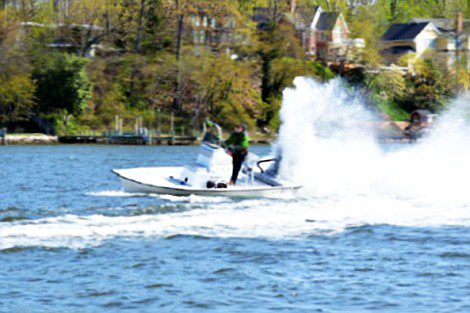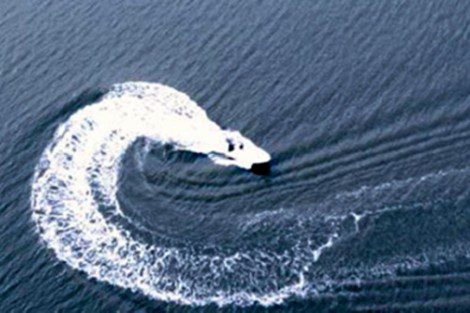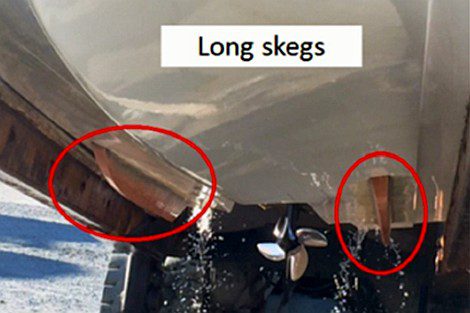 By Bob Currie, Recreational Boating Safety Specialist
By Bob Currie, Recreational Boating Safety Specialist
U. S. Coast Guard Auxiliary Station Galveston Flotilla
One of the most popular styles of boats I see out on Galveston Bay is the shallow water flats boat. They are great fishing platforms, giving the occupants more room to move about that the average center console boat which has a 2- to 2.5-foot-high gunwale. The shallow water boats have little or no gunwale, thus allowing the occupants to move more freely about the boat. In addition, they all have power jack plates to help them negotiate very shallow water. Most have enough power to really scoot over the water from reef to reef.

End Swapping Event
An end swapping event occurs when a boat enters a turn and loses its ability to maintain steerage contact with the water and in some cases violently spins out. The end swapping event can and often does result in ejection of boat occupants, resulting in injury and in some cases death. End swapping occurs during turns made at speed.
Boats Prone to End Swapping
The boats most prone to end swapping are boats specifically designed for shallow water fishing. The majority of these boats are mostly flat deck with little or no gunwales or railings, and in general have a center console with seating at the console. An example of this style of boat is the Texas Flats style of boat. Other types include tunnel vee boats, flats skiffs, and sleds. From a distance they look like a surfboard with a motor flying across the bay. The boats generally have enough horsepower to propel the boats at speeds above 40 mph, with some boats reaching 50 mph and higher. The average speed at which end swapping becomes a concern is 25 mph.
Boat Design Issues
The Coast Guard has done extensive studies regarding the propensity of certain boat hull designs to swap ends during a turn. The boats at issue are intended to operate in shallow water. These boats all have the same four design characteristics that set them up for dangerous end swapping when a turn is made. First, they have incorporated a tunnel along the center line in the aft portion of the hull to permit the engine to operate in an elevated position on a jack plate. Second, they have a high dead rise or deep vee in the forward part of the hull. Third, they tend to have very little, if any, containment for the occupants and operator. Finally, they use an oversized anti-ventilation plate on the outboard engine.
Outboard Ventilation
Ventilation is the propeller sucking in air. When this happens, all thrust is lost. This may happen because you have the engine trimmed up too high. It can occur when the boat is jumping waves and the back of the boat is actually coming up near the surface of the water. In the case of end swapping, it occurs when you make a sharp turn and as the boat leans the propeller comes too close to the surface. Another reason for ventilation during a turn is due to the flow of water through the tunnel. The tunnel is designed to direct water flow to the propeller, and during a turn that direction of flow is interrupted if the turn is sharp and made above a certain speed. The speed at which ventilation occurs depends on how high the engine is raised by the jack plate and how sharp the turn is made. The Coast Guard has found that the speed of concern is 25 mph, but ventilation can occur at speeds lower than 25 mph. When forward thrust is lost during a turn, the bow digs in and the boat makes a 180-degree spin. This 180-degree spin can cause occupants to be ejected and the boat can even flip over. It should be noted that when ventilation occurs the engine will over-rev and severe engine damage may occur. If your engine ventilates, reduce throttle immediately, even if you are not in a turning situation.
Boat Loading
Most center console boats have a seat just forward of and attached to the center console. They usually have either an ice chest or live well below the seat. Forward loading of the boat tends to make the boat more prone to end swapping, so it is not recommended that this seat be occupied when under way, especially in shallow water, as shallow water running also tends to lower the bow and make it more prone to digging in.
Coast Guard Evaluation and Testing
When the Coast Guard began to see an increase in boating accidents due to end swapping, they initiated a study to determine why this was happening. Their first realization was that end swapping occurred mostly on shallow water boats. They began testing hull designs in order to better understand this phenomenon. They used the ABYC (American Boating and Yacht Council) H-26 Powering of Boats Standard, which prescribes procedures for testing of boat hull turning characteristics. The particular procedure they used is called the Quick Turn Test and is used for testing boats capable of exceeding 30 mph and controlled by a steering wheel rather than a tiller.
 ABYC Quick Turn Test
ABYC Quick Turn Test
Boat Modification
Another part of the Coast Guard study was to determine if modifications could be made to reduce or eliminate the end swapping tendency. After trying different modifications, the Coast Guard found that adding two 72-inch skegs 4.5 inches tall allowed boats that had previously failed the quick turn test to pass the test. The increased hull-to-water contact provided by the skegs improved the directional stability of the boat and greatly decreased the tendency of the stern to end swap.

What This Means for You
I like to fall back to Clint Eastwood’s Dirty Harry for advice when possible. He always had good advice. In this case it would be “A boater has got to know his boat’s limits.” If you have one of the boats discussed here, your biggest weapon against end swapping is knowledge. Know whether your boat has a tendency to end swap; read your boat’s manual. The study of this phenomenon is fairly recent, so if your boat was manufactured before 2016 your manual may not make mention of end swapping, but it may mention how it handles during turns, and it may make recommendations on such. It is sure to discuss ventilation and cavitation and how the two phenomena occur, and that knowledge will add to your arsenal to prevent end swapping. The Coast Guard has recommended that manufacturers discuss end swapping and apply a label with the boat’s maneuvering speed, A boat’s maneuvering speed is the maximum speed at which the boat can complete the maneuvers required by the ABYC H-26 Powering of Boats standard. If you can’t find that speed for your boat in your manual, you can contact the manufacturer for that information.
Summary
Not all shallow water flats boats are constructed the same, so it is not possible to pick a specific speed and say it is hazardous. Coast Guard testing has shown an end swapping event is possible at speeds as low as 25 mph. It is well known that a boat’s performance changes as you go into shallow water. Generally, it runs at a lower trim angle, and that alone makes the boat more prone to the bow digging in and causing an end swap. When you add speed and the propensity of an outboard to ventilate when the jack plate is raised, you have all the conditions necessary for an end swap to occur. Armed with this knowledge and by becoming more familiar with your own boat’s operating characteristics, you can reduce the chance that you will be involved with a dangerous end swap.
For more information on boating safety, please visit the Official Website of the U.S. Coast Guard’s Boating Safety Division at www.uscgboating.org. Questions about the U.S. Coast Guard Auxiliary or our free Vessel Safety Check program may be directed to me at [email protected]. SAFE BOATING!
[May-24-2022]

 Posted in
Posted in 























